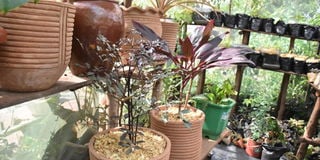Mulching with wood shavings

Use wood shavings on already established plants. PHOTO/Desire Mbabaali
What you need to know:
Like the case with any other mulch, just spread a good amount of wood shavings on top of the soil to form a good layer of wood shavings
Without a doubt, mulching your garden or potted plants is one of the best practices every gardener needs to think about and adopt. Mulching is the application of a layer of material on top of exposed soil to protect and enhance it in different ways.
Although there are various materials to work with to mulch that include coffee or rice husks, tree barks, wood chips, banana plantation chips, hay, straw, dry leaves and even plastic sheets, today, we discuss using wood shavings as a mulch.
Why wood shavings?
To begin with, according to Isaac Kalule Balimwewunya, a gardener and landscaper from Kani Green Care Solutions, wood shavings can be got from any sawmill thus making the resource locally and readily available. These can be bought from any carpentry shop. He notes that it is affordable as well with a sack going for Shs5, 000 in Ndeeba, on the outskirts of Kampala, for example, depending on the demand. Although the prices fluctuate sometimes, they remain within an affordable price range.
They are also a mulch that helps to keep the soil moist, and protected thereby making the plant less likely to lose a lot of water, especially during the sunny season.
“Wood shavings also prevent pests such as snails from attacking the plants. They are also aggressive in preventing weed growth in the garden,” Kalule adds.
With time, they decompose to form organic manure which can be used in the growth of the plant. As they decompose, they also mix up with soil and improve soil drainage.
“The winner for me about wood shavings is that they take a long time before decomposing, which is not the same with straw, hay or dry leaves. This in the long run makes using wood shavings a cheaper option,” Kalule notes.
They also beautify the garden and pots if the plants are potted so that the soil is not exposed. They thus prevent soil from splashing, keeping the pot clear of mud during watering or when it rains.
“Nowadays, people are using pebbles and terrazzo stones for mulching. Although they are visually impressive, they are not very good for use because when it shines, they absorb heat which ends up damaging the stem of the plant. This is not the case with wood shavings which do not absorb heat,” Kalule advises.
How to use wood shavings
Like the case with any other mulch, just spread a good amount of wood shavings on top of the soil to form a good layer of wood shavings. “Leave some space around the plant itself to prevent the plant from being damaged from any chemical reactions that are going on between the soil and the wood shavings. Wood shavings need a good amount of nitrogen in their decomposing process, so keeping them off the plant may come in handy,” Noreen Bukirwa, a gardener also advises.
If being applied to a plant in a pot, place the wood shavings around the entire surface of soil around the pot.
Wood shavings can be used in raised or vertical gardens, in a pot or on the ground.
When watering, do not remove the shavings but rather pour water on top of them.
Beware
“If you have a termite problem, using wood shavings might be a challenge more than an advantage because termites feed on wood and so, the shavings might harbour them. These may also damage the plants especially if they are woody plants,” Bukirwa cautions.
She also adds that wood shavings, chips and sawdust absorb large amounts of nitrogen from the soil which they need during the decomposing process.
“Plants equally need nitrogen to thrive and so, wood shavings deprive the plants of nitrogen. I would therefore, advise that these are either used in a plain garden, so that by the time crops are planted, nitrogen and more have been released back into the soil. Alternatively, use wood shavings on already established plants because they can be able to absorb nitrogen from deep within the soil since their roots are already established,” she advises.




